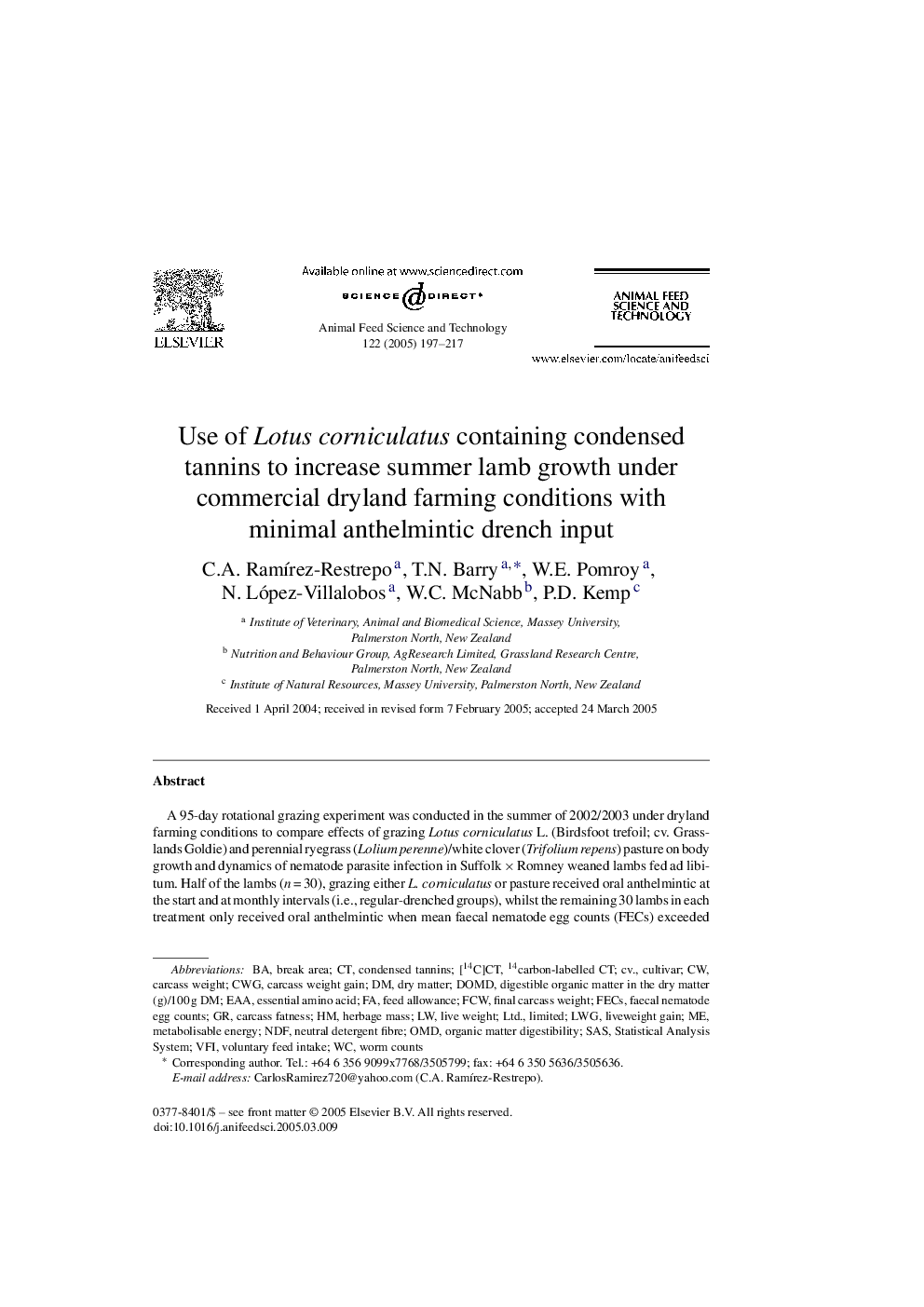| کد مقاله | کد نشریه | سال انتشار | مقاله انگلیسی | نسخه تمام متن |
|---|---|---|---|---|
| 8973658 | 1552508 | 2005 | 21 صفحه PDF | دانلود رایگان |
عنوان انگلیسی مقاله ISI
Use of Lotus corniculatus containing condensed tannins to increase summer lamb growth under commercial dryland farming conditions with minimal anthelmintic drench input
دانلود مقاله + سفارش ترجمه
دانلود مقاله ISI انگلیسی
رایگان برای ایرانیان
کلمات کلیدی
NDFDryland farming systemsDOMDLWGCWGOMDFaecal nematode egg countsCarcass fatnessWorm countsVFIEAAFCWSASEssential amino acid - اسید آمینه ضروریLiveweight gain - افزایش وزن زندهmetabolisable energy - انرژی قابل متابولیسمCondensed tannins - تانن های متراکم یا تانن های فشردهHerbage mass - جرم گیاهیcv. - رزومه.Cultivar - رقم، تیپ، کولتیوارStatistical Analysis System - سیستم تحلیل آماریneutral detergent fibre - فیبر مواد شوینده خنثیLotus corniculatus - لوتوس کریکولیوسdry matter - ماده خشکLimited - محدودVoluntary feed intake - مصرف خوراک داوطلبانهOrganic matter digestibility - هضم ماده آلیLive weight - وزن زندهCarcass weight - وزن لاشه
موضوعات مرتبط
علوم زیستی و بیوفناوری
علوم کشاورزی و بیولوژیک
علوم دامی و جانورشناسی
پیش نمایش صفحه اول مقاله

چکیده انگلیسی
A 95-day rotational grazing experiment was conducted in the summer of 2002/2003 under dryland farming conditions to compare effects of grazing Lotus corniculatus L. (Birdsfoot trefoil; cv. Grasslands Goldie) and perennial ryegrass (Lolium perenne)/white clover (Trifolium repens) pasture on body growth and dynamics of nematode parasite infection in Suffolk Ã Romney weaned lambs fed ad libitum. Half of the lambs (n = 30), grazing either L. corniculatus or pasture received oral anthelmintic at the start and at monthly intervals (i.e., regular-drenched groups), whilst the remaining 30 lambs in each treatment only received oral anthelmintic when mean faecal nematode egg counts (FECs) exceeded 1000 eggs/g wet faeces (i.e., trigger-drenched groups). This only occurred on day 58 for both groups. Trigger and regular-drenched lambs grazed separate areas. Total condensed tannin (CT) concentration in the diet selected was 31-40 g CT/kg DM for L. corniculatus, with only trace amounts in pasture. In vitro organic matter (OM) digestibility (OMD), digestible OM in dry matter (DOMD), and metabolisable energy (ME) concentration were higher for L. corniculatus versus pasture and declined less under drought conditions versus grass-based pasture. Regular-drenched lambs grazing L. corniculatus had higher liveweight gain (LWG; 298 g/day) and carcass weight gain (133 g/day) than all other groups, whilst trigger-drenched lambs grazing L. corniculatus had higher LWG (228 g/day) and carcass gain (99 g/day) versus regular-drenched (200; 66 g/day) and trigger-drenched (187; 63 g/day) lambs grazing pasture. Carcass fatness was lower for trigger-drenched lambs versus regular-drenched lambs, when fed either L. corniculatus or pasture. Dag score was consistently lower for regular-drenched lambs grazing L. corniculatus versus pasture; trigger-drenched lambs showed similar effects up to day 48, with no differences between the groups thereafter. Regular anthelmintic treatment maintained FECs at low values, while parasitised grazed lambs on L. corniculatus tended to have higher FECs than pasture fed lambs. Relative to trigger-drenched lambs that grazed pasture, grazing L. corniculatus reduced worm burdens at slaughter of Haemochus contortus, Teladosargia spp., Nematodirus spp. and Cooperia spp., but higher burdens of Trichostrongylus spp., Chabertia ovina, Oesophagostonum spp. and Trichuris ovis ocurred in L. corniculatus fed lambs. Grazing Lotus corniculatus L. (Birdsfoot trefoil; cv. Grasslands Goldie) under dryland farming conditions can increase growth of weaned lambs, whilst reducing reliance on anthelmintic drenches to control parasites. These effects are possibly due to increased metabolisable protein supply, from the protein binding action of CT, enabling the lambs to grow faster when carrying a parasite burden, and to L. corniculatus better maintaining its high ME value under drought conditions. Mechanisms for the action of CT are discussed.
ناشر
Database: Elsevier - ScienceDirect (ساینس دایرکت)
Journal: Animal Feed Science and Technology - Volume 122, Issues 3â4, 1 September 2005, Pages 197-217
Journal: Animal Feed Science and Technology - Volume 122, Issues 3â4, 1 September 2005, Pages 197-217
نویسندگان
C.A. RamÃrez-Restrepo, T.N. Barry, W.E. Pomroy, N. López-Villalobos, W.C. McNabb, P.D. Kemp,